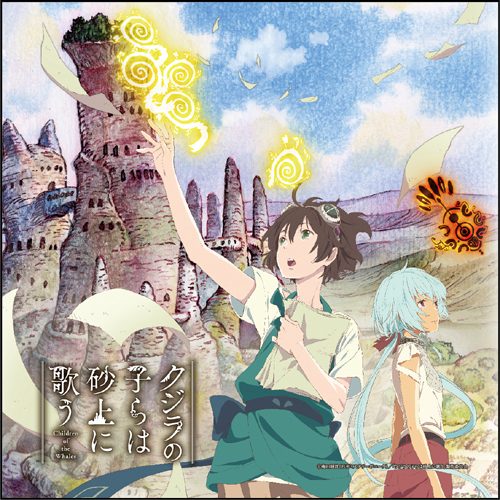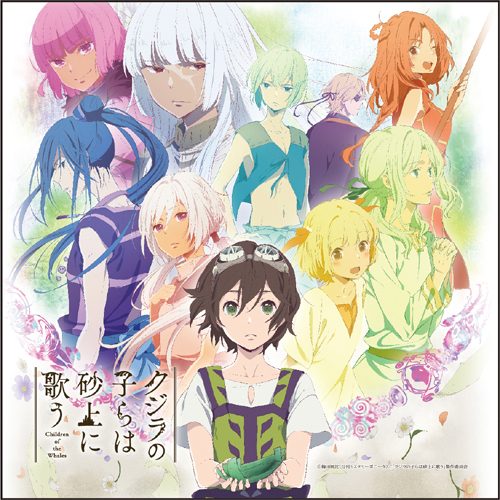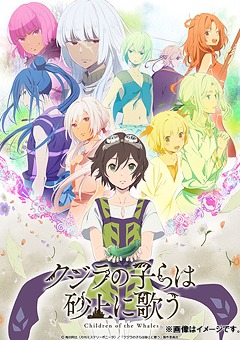
All About the Setup
- Episodes : 12
- Genre : Drama, Fantasy, Mystery, Sci-Fi, Shoujo
- Airing Date : Oct 8, 2017 to Dec 24, 2017
- Studios : J.C. Staff
Contains Spoilers
Kujira no Kora wa Sajou ni Utau Introduction and Story (Spoilers)
Kujira no Kora wa Sajou ni Utau is an anime that might have gone unnoticed. With Toradora! And Shokugeki no Souma underneath its belt, J.C. Staff is a highly reputable studio that tends to deliver entertaining and intelligent series on a regular basis. Children of the Whales promised to be more of the same, but the fantasy series is only available via Netflix in a handful of regions. Due to this restricted distribution practice, J.C. Staff’s anime is not immediately accessible to every fan who might be interested. A quick glance at MyAnimeList.net reveals that the group dedicated to Children of the Whales has less than 60,000 members, while other new shows like Blend-S and Juuni Taisen earned more than double that amount. So, does Kujira no Kora wa Sajou ni Utau deserve better? Is it a series worth seeking out?
he Mud Whale is a strange ship that traverses an endless sea of sand. The vessel’s inhabitants are divided into two distinct groups; the marked and unmarked. Those belonging to the former are blessed with an ability known as thymia, allowing the manipulation of objects using their energy. While this makes the marked highly useful in work and combat situations, their lives tend to be short, with most lasting until their late 20s. On the flip side, the unmarked possess no special powers but lead lengthy lives. Due to the latter’s longer lifespan, they are deemed the rulers of the Mud Whale, with anyone above the age of 62 automatically joining the Elders Council. Once that age is reached, the unmarked are educated on the Mud Whale’s history.
Chakuro is a 14-year-old marked archivist, who wants to document the Mud Whale’s journey for future generations. During a random expedition to a nearby island, he discovers a mysterious and emotionless girl named Lykos. On the verge of death, she is taken back to the Mud Whale, where she explains that these ships are controlled by a fantastical creature known as a nous. Lykos hails from the Empire, a powerful country that seeks to destroy the Mud Whale due to an ancient legend stating that warriors known as the daimon reside on the island. In the Empire, the nous feeds on people’s emotions, while the Mud Whale’s entity prefers the marked’s life force. The Empire attacks Chakuro’s ship, killing many people along the way, but the young Ouni reveals himself to be a daimon and takes down the enemy’s battleship. For their troubles, Chakuro receives a rudder, and the Mud Whale can finally be steered in a specific direction. As they consider their next move, the Empire’s Oruka makes the necessary preparations for another attack.
What We Liked About Kujira no Kora wa Sajou ni Utau
Whether someone loves or hates J.C. Staff's latest anime, nobody can deny that Kujira no Kora wa Sajou ni Utau is breathtaking. In this instance, we are not speaking about the animation itself, rather the artistic decisions made when it comes to the design of the characters and environments. The Mud Whale is a feast for the eyes, with many moving layers that harbor back to Studio Ghibli classics like Castle in the Sky. The sandy sea adds an air of dread and mystery to the entire premise, serving as a makeshift prison for the residents of the ship. Ignoring the personalities of the cast, for the moment, the studio crafted pleasing characters who are visually diverse and easily identifiable.
J.C. Staff has tried to create a series capable of pleasing everyone. There is a strong sense of adventure prevalent throughout the narrative, while quite a few cool action sequences are thrown into the mix. Children of the Whales is not afraid to slow down for a moment or two, including a few genuinely funny scenes that help alleviate some of the tension. The anime is by no means a comedy, but the story goes through an array of emotions. At the very least, Kujira no Kora wa Sajou ni Utau cannot be criticized for being one-note.
It should be noted that Children of the Whales requires a follow-up season. These twelve episodes prioritize world-building and setting up the main conflict, but there is barely any payoff. A few mysteries -like how the Mud Whale's nous feeds itself- are answered, but there is clearly a lot more going on. The expansive cast requires considerably more than 12 episodes to be properly fleshed out, but J.C. Staff did a decent enough job of setting up the stage for future installments.
Discussion Time
Kujira no Kora wa Sajou ni Utau is based on an ongoing manga written by Abi Umeda. The series started in 2013 and 10 volumes have since been released, but only last November was the first made available in English. In other words, Children of the Whales is a relatively unknown franchise outside of Japan. Admittedly, that kind of explains why the adaptation was only (legally) distributed via Japan's Netflix. There is a great sense of spirituality to the storyline, with the Mud Whale's residents often engaging in prayer during moments of distress.
Does the above make Children of the Whales inaccessible for an international audience? Hardly. Yes, the anime is soaked in fantastical elements that might seem alien to some of us, but it is hard to not be swept away by its sense of wonder. If nothing else, J.C. Staff crafted an animation spectacle that boasts one of the best soundtracks of the Fall 2017 season. There is a surprising amount of blood and death, therefore, Children of the Whales might not be ideal for a younger audience.

If you love anime like Shinsekai Yori, Kujira no Kora wa Sajou ni Utau is worth a try. The anime works best when focusing on the lives of the Mud Whale’s inhabitants. They are a generally cheery bunch, despite their doomed situation and short lives. They are constantly seeking to find meaning in their struggles, as they form bonds with each other and attempt to break through a hundred-year cycle.
J.C. Staff has not created perfection, but Children of the Whales tends to deliver in most areas. The plot is engaging enough to keep someone interested for the season's duration, while the majority of the cast is likable. Action is not in short supply and there are a few touching moments spread throughout the 12 episodes. The opening two episodes are arguably the best of the bunch and should provide a good indication of whether this anime is for you.
1. Pleasing to the Eyes
The animation's beauty cannot be overstated. It goes beyond just a pleasing art style, as the visuals are cleverly used to reflect and amplify the emotions echoed by the story. Most of the season is confined to the Mud Whale's interior corridors, but the animators manage to keep the repetitive environments fascinating enough to avoid the onset of boredom. Whenever the story allows for a bit of visual splendor, like the first time the rudder is used on the Mud Whale, prepare to have your breath taken away.
2. Intellect or Emotion
It is too early to describe Children of the Whales as a philosophical anime, but a few potentially interesting questions are introduced. The main conflict seems to ponder whether emotions should be sacrificed in the pursuit of intellectual advancement. The Empire sold its heart for power, while the Mud Whale's marked children have unwittingly forfeited their lifespans to experience emotions. This question is yet to be tackled in depth, other than Chakuro’s monologue about the importance of memories, but it adds another layer of intrigue to the overall concept.
3. The Sound of Music
After the art, the Children of the Whales soundtrack deserves the most recognition. Jin Aketagawa served as the anime's sound director, and he brings his A-game. Since this is an atmospheric series, the music aims to complement the story rather than overwhelm it, greatly enhancing the emotional impact of the scenes. In terms of music, the standout moment happens during a pivotal battle sequence that determines the faith of the Mud Whale.
Children of the Whales suffers from a lack of closure. As long as a follow-up season is created, these 12 episodes of buildup are perfectly fine. Unfortunately, season two is yet to be announced by the studio. J.C. Staff is a relatively big organization, so, there is hope that a sequel will be green-lit.
For fans of fantasy anime, Kujira no Kora wa Sajou ni Utau is unlikely to hold much in the way of surprises. While the Mud Whale's backstory is pretty interesting, the present day story meanders at the best of times. It is by no means terrible, but the twists and turns can be seen coming from a mile away. For example, the marked children only learn that the nous is feeding on their life-force during the last two episodes. Despite this plot point being obvious from around the halfway mark of the season, it is presented as an earth-shattering revelation.
1. Chakuro
Right out of the bat, Chakuro is a terrible and bland protagonist. The lead does not need to be heroic or powerful, but the archivist can either be found crying or screaming Ouni's name while the daimon actually does something. Apparently, crying like a baby is worthy of praise, as multiple characters appear just to declare Chakuro's awesomeness. This would make sense if he were the only person with emotions, but that is the norm on the Mud Whale. As a far more interesting person, Ouni would have benefitted from Chakuro's screen time.
2. Action
Thankfully, the gorgeous animation and soundtrack mask the uninspired and static action sequences. Over the course of 12 episodes, there are two major battles between the Mud Whale and the Empire. Despite introducing special powers like the thymia, the fights generally amount to people throwing stones towards each other. The scenes are rather bloody and loud, but they move at a snail's pace. Things do improve once Ouni unlocks his daimon abilities, but that amounts to about half an episode.
Final Thoughts
J.C. Staff's Children of the Whales might develop into a fantastic anime. The Fall 2017 season did a decent job of setting up the world and characters, but there needs to be a payoff. The bland protagonist and lackluster action sequences drag down the entire experience, but those are elements that can be improved within the second season. At this point, it is just about worth a watch for those who already have access to it.
Did you agree with our review? Is Kujira no Kora wa Sajou ni Utau worth a watch? Please let us know in the comments below!



